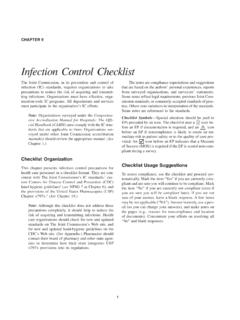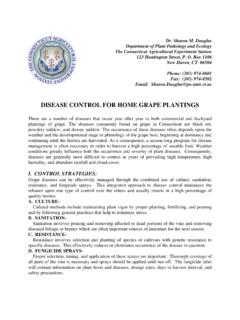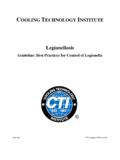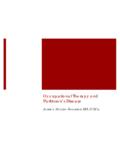Transcription of DISEASE CONTROL FOR HOME APPLE ORCHARDS …
1 Dr. Sharon M. Douglas Department of Plant Pathology and Ecology The connecticut Agricultural Experiment Station 123 Huntington Street, P. O. Box 1106 New Haven, CT 06504 Phone: (203) 974-8601 Fax: (203) 974-8502 Email: DISEASE CONTROL FOR home APPLE ORCHARDS There are a number of diseases that commonly occur year after year in both commercial and backyard plantings of apples. These diseases do not infect at the same time but appear in a fairly regular sequence depending upon the weather and the development or phenology of the APPLE host, beginning at dormancy and continuing until fruit are harvested. As a consequence, a season-long program for DISEASE management is often necessary in order to harvest a high percentage of useable fruit.
2 The diseases which are common in APPLE include APPLE scab, cedar- APPLE rust, black rot, and the summer diseases, sooty blotch and flyspeck. Powdery mildew is an occasional problem on certain APPLE cultivars. Fire blight is another sporadic problem but when it occurs, it can be extremely destructive. Weather conditions greatly influence both the occurrence and severity of plant diseases. Consequently, diseases are generally most difficult to CONTROL in years of prevailing high temperature, high humidity, and abundant rainfall and cloud-cover. I. CONTROL STRATEGIES: APPLE diseases can be effectively managed through the combined use of culture, sanitation, resistance, and fungicide sprays. This integrated approach to DISEASE CONTROL minimizes the reliance upon one type of CONTROL over the others and usually results in a high percentage of quality fruit.
3 A. CULTURE- Cultural methods include maintaining tree vigor by proper planting, fertilizing, and pruning and by following general practices that help to minimize tree stress. B. SANITATION- Sanitation involves pruning and removing affected or dead portions of the tree and removing diseased foliage or fruit which are often important sources of inoculum for the next season. C. RESISTANCE- Resistance involves selection and planting of varieties with genetic resistance to specific diseases. This effectively reduces or eliminates occurrence of the DISEASE in question. D. FUNGICIDE SPRAYS- 2 Proper selection, timing, and application of these sprays are important. Thorough coverage of all parts of the tree is necessary and sprays should be applied until run-off.
4 The fungicide label will contain information on plant hosts and diseases, dosage rates, days to harvest interval, and safety precautions. II. COMMON DISEASES: A. APPLE SCAB- APPLE scab, caused by the fungus Venturia inaequalis, is the most important DISEASE of APPLE in New England and is most severe in wet weather. The fungus causes circular, olive-black spots on the leaves, fruit, and young fruit stems. Heavy infections can result in defoliation and affected fruit can drop, become distorted, and crack. The fungus overwinters on dead, fallen leaves and produces spores (primary) in the spring which can infect sepals, young leaves, and young fruit during periods of rain. Infection from these primary spores can take place at any time after APPLE growth begins until mid to late June if suitable weather conditions exist.
5 During the summer a different spore (secondary) is produced by the fungus which is capable of inciting more new infections when splashed onto leaves and fruits by rain. APPLE scab is most effectively controlled by planting resistant varieties such as Jonafree, Priscilla, Macfree, and Liberty. A good sanitation program in which diseased leaves and fruit are removed from the vicinity of the tree will also help to eliminate sources of inoculum in the spring. Scab can also be controlled with properly selected and timed fungicide sprays (refer to spray guide on page 5). B. GYMNOSPORANGIUM RUSTS (Cedar- APPLE rust, hawthorn rust, and quince rust) Several rusts commonly infect apples.
6 Cedar- APPLE rust, caused by the fungus Gymnosporangium juniperi-virginianae, is a problem when APPLE and certain species of juniper and red cedar grow in close proximity. This rust requires two different hosts to complete its life cycle. The fungus causes brilliant yellow-orange or reddish spots or lesions on APPLE leaves and occasional lesions on the calyx end of fruit. On cedar, the fungus produces brown to reddish-brown galls, - 2 in diameter. During rainy periods in the spring, distinctive bright orange, gelatinous, spore-horns protrude from the surface of these galls. The spores are blown by the wind to APPLE trees where they infect and produce their characteristic lesions. Hawthorn rust is caused by Gymnosporangium globosum, a fungus which is related to the cedar- APPLE rust fungus.
7 Because these fungi are so closely related, the diseases caused by them are very similar. Cedar-hawthorn rust also requires two different hosts in order to complete its life cycle- these include Juniperus species ( , eastern red cedar) as well as many rosaceous species such as APPLE , crabapple, hawthorn, pear, quince, and serviceberry. The DISEASE cycle is essentially the same as previously described for cedar- APPLE rust. Cedar-hawthorn rust usually infects leaves but can also produce symptoms on fruit and green stems which results in deformity. These symptoms help to distinguish hawthorn rust from cedar- APPLE rust. Additionally, hawthorn rust produces slightly smaller, more flattened galls on the juniper hosts.
8 Quince rust is caused by another Gymnosporangium species, G. clavipes. This rust also has a similar life cycle to cedar- APPLE and hawthorn rust and requires two different hosts, junipers and 3 several members of the Rose family. Quince rust infects fruit but not leaves of APPLE but both fruit and leaves of other hosts such as quince, hawthorn, and other Roseaceous species. Symptoms appear on APPLE fruit as dark green lesions at the calyx end. These lesions cause puckering and distortion of the fruit and are brown and spongy down to the core. This fungus produces spindle-shaped or cylindrical galls or swellings on the juniper hosts. Removal of red cedars located in close proximity to and up to one mile from the APPLE tree or planting usually reduces the number of spores capable of infecting APPLE although this is often not practical.
9 Therefore, selecting and planting resistant varieties is the most effective way to CONTROL rust diseases. Unfortunately APPLE cultivars resistant to one type of Gymnosporangium rust are not necessarily resistant to all of them. For example, cultivars Delicious, Empire, Jonamac, McIntosh, and Paulared are resistant to cedar- APPLE rust but McIntosh is susceptible to hawthorn rust. Protective fungicide sprays applied to APPLE can also prevent infection (refer to spray guide on page 5). C. POWDERY MILDEW- Powdery mildew, caused by the fungus Podosphaera leucotricha, is usually only a problem in fairly dry, hot summers. This fungus produces a superficial white powdery growth on the foliage, blossom buds, and immature twigs of APPLE .
10 Fruits show russeting in cases of severe infection. This fungus overwinters as mycelium (fungal strands) in the dormant buds. As these infected buds open in the spring, spores called conidia are produced and are carried by the wind to newly emerging leaves and blossoms where they cause DISEASE . This DISEASE can be controlled by planting mildew-resistant varieties such as Freedom, Jonafree, Liberty, and Priscilla. In addition, sanitation by pruning to remove infected terminals and to increase air circulation within the canopy and fungicide sprays can greatly reduce the inoculum (refer to spray guide on page 5). D. BLACK ROT- Black rot, caused by the fungus Botryosphaeria obtusa, is also known as frogeye leaf spot and is often associated with unusually warm seasons.















